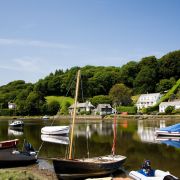The Helford Estuary, sandwiched between Falmouth and the Lizard peninsula, comprises fifty miles of unspoilt shoreline, less rugged and more gentle than in many other parts of the county, and home to a wealth of wildlife habitats, from rocky shore and reef to sandbars, mudflats and tree-fringed, muddy-shored creeks.
Created by rising sea levels at the end of the last Ice Age, the sands and mud of the main estuary (a drowned river valley) make rich feeding grounds for a great variety of birds, especially at low tide, including the majestic Grey Heron and it's smaller, white cousin, the rare Little Egret, now living in increasing numbers in the creeks of the upper river.
Perhaps due to it's unspoilt nature (which goes hand in hand with restricted access and difficult viewing points) the Helford Estuary has never achieved the cult status of other birdwatching sites in Cornwall, although there is plenty to see, from Mute Swans, Canada Geese and Grey Heron to Tufted Duck, Kingfisher, Coot, Water Rail, Reed Warbler and Little Grebe.
The Helford bird population begins to increase in early autumn and continues to build until mid-winter as migrating species, such as Curlew, Redshank, Dunlin and Turnston, either stop to rest and re-fuel or settle in for the winter. To access the estuary on the Lizard side, simply follow signs to the Lizard from Helston and turn off towards Manaccan and the Helford village.
Alternatively head towards Falmouth on the A394 and turn off for Gweek or Constantine.






